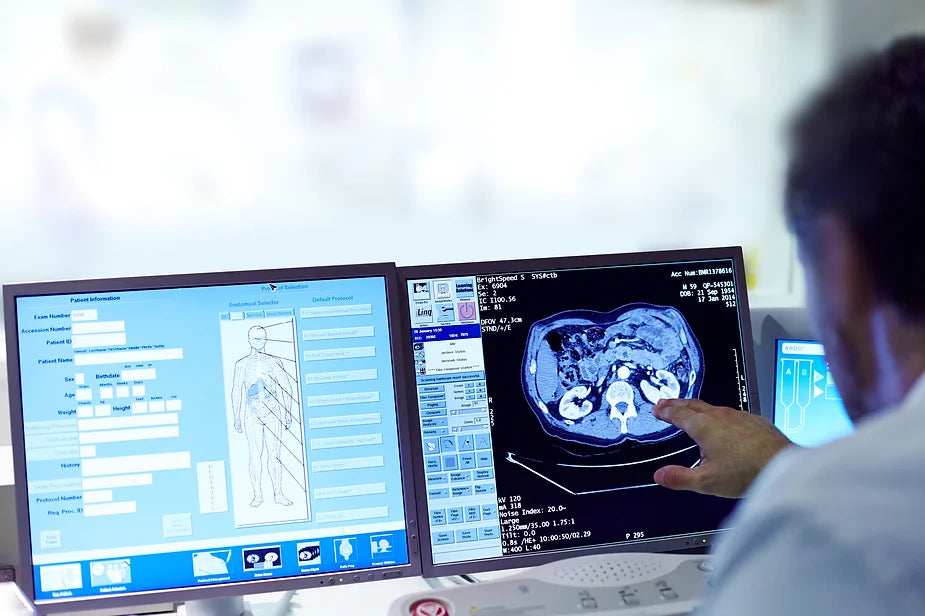What is Chorionic Villus Sampling (CVS)?
Chorionic villus sampling (CVS) is a prenatal test that checks your baby for genetic abnormalities. It is commonly performed between 10 and 12 weeks of pregnancy, and takes a small sample of the developing placenta. The sample is collected using a slender needle which is inserted through your abdomen and into the placental tissue. The tissue (chorionic villi) is then examined in a laboratory.
Why might I choose CVS instead of amniocentesis?
Chorionic villus sampling (CVS) differs from amniocentesis in that it takes placental tissue, as opposed to amniotic fluids. It’s main advantage over amniocentesis is that it can be performed earlier -- between the 10th and 14th weeks of pregnancy. You generally can't have an amniocentesis until 15 weeks of pregnancy.
Some women choose CVS because they already have a child with a birth defect, or they have a family history of a genetic disease such as Tay Sachs and they want to know as soon as possible whether this baby is affected. Many hospitals offer CVS and it has become a popular alternative to amniocentesis.
Is CVS more likely than amniocentesis to cause a miscarriage?
The risk of miscarriage is slightly higher following CVS (approximately 1 per cent) than following amniocentesis (approximately 0.5 per cent).
Very occasionally, an abnormality known as mosaicism shows up on the CVS test when it doesn't actually exist in the baby. This is because it can be present in the placenta and therefore shows up on the CVS. If you receive this diagnosis, your doctor or midwife will discuss with you whether you would like to have an amniocentesis to confirm the result.
Are there any risks?
Some of the side effects, risks and possible complications of CVS include:
- Light-headedness
- Abdominal discomfort
- Pains that feel similar to menstrual cramps
- Haemorrhage
- Infection
- Ruptured amniotic sac
- Miscarriage, estimated at one in 100
- Increased risk of limb defects if the test was performed at nine weeks’ gestation or earlier
- Inaccurate or unclear test results, estimated at one per cent.
If you're uncertain whether to have CVS, or if you're very anxious about the procedure, be sure to voice your concerns with your midwife, doctor or genetic counselor beforehand, who will be able to give you a full account of the pros and cons, and tell you exactly what happens when the procedure is performed.
If the risks of CVS and amniocentesis are about equal, why doesn't everyone have CVS?
CVS is not available everywhere, particularly not in rural and regional Australia. Also you may not have discovered that you were pregnant until it was too late for CVS, or you may have experienced a previous first trimester miscarriage and be unwilling to run that risk again.
Deciding which antenatal test (if you wish to have any at all) to have is a very personal decision. You may opt to have CVS if you have a very specific reason to believe that there might be something wrong with your baby and you want to find out as soon as possible. On the other hand, you might choose to wait for an amniocentesis and minimise the risk of miscarriage.
How is CVS performed?
Your prenatal provider should give you the opportunity to discuss the pros and cons of CVS prior to conducting it. Make a list of all the questions you want to ask so you don’t forget them when you get to the hospital.
You'll be asked to lie down for the test. First an ultrasound scan is performed to confirm how many weeks pregnant you are, and to locate the placenta.
A needle is then inserted through your abdomen to the placenta. In a small number of cases you may be recommended to have a transvaginal CVS; where a fine tube is thread through your vagina. For a transabdominal CVS, you will be given a local anaesthetic to numb the wall of your abdomen before the needle is inserted.
Your doctor then extracts a fragment of chorionic villi, which are tiny fingerlike projections on the placenta. These cells are full of genetic information that can be analysed to reveal the chromosomal make-up and the sex of your baby. If you don't want to know whether you're having a boy or girl, let your doctor know now! Will it hurt?
Many women find the procedure uncomfortable, and some find it painful. However, it's over relatively quickly. The test lasts no longer than half an hour from start to finish, and actually taking the sample is only a matter of a few minutes. Some women who have a transabdominal CVS report having a sore tummy after the test.
What happens after the test?
Having a CVS or amniocentesis or any other antenatal test can be physically and emotionally exhausting. Your carer will advise you to rest afterwards and arrange someone else to drive you home. If you can, spend the rest of the day relaxing and avoid any vigorous exercise or sex for three days. You may have some cramping in your tummy and a slight loss of blood from the vagina in the first 24 hours after the test. These are possibly normal side effects, but let your doctor or midwife know. If you notice clear fluid leaking from your vagina, contact your doctor or midwife immediately.
You might have to wait up to a fortnight for the results of the CVS. This is probably going to be a very difficult time. It might help to keep busy, and give yourself several treats to help pass the time as easily as possible.
betterhealth.vic.gov.au. (2020). Pregnancy tests – chorionic villus sampling. Retrieved from https://www.betterhealth.vic.gov.au/health/ConditionsAndTreatments/pregnancy-tests-chorionic-villus-sampling#:~:text=Things%20to%20remember-,Chorionic%20villus%20sampling%20(CVS)%20is%20a%20pregnancy%20test%20that%20checks,needle%20inserted%20through%20the%20abdomen.

